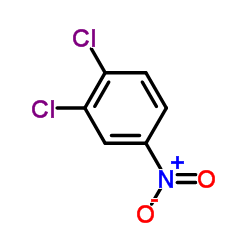

1,2-二氯-4-硝基苯结构式
|
常用名 | 1,2-二氯-4-硝基苯 | 英文名 | 1,2-Dichloro-4-nitrobenzene |
|---|---|---|---|---|
| CAS号 | 99-54-7 | 分子量 | 191.999 | |
| 密度 | 1.5±0.1 g/cm3 | 沸点 | 255.5±0.0 °C at 760 mmHg | |
| 分子式 | C6H3Cl2NO2 | 熔点 | 39-41 °C(lit.) | |
| MSDS | 中文版 美版 | 闪点 | 123.9±0.0 °C | |
| 符号 |

GHS07 |
信号词 | Warning |
|
Short-term black tea intake modulates the excretion of urinary mutagens in rats treated with 2-amino-3-methylimidazo-[4,5-f]quinoline (IQ): role of CYP1A2 upregulation.
Arch. Toxicol. 78(8) , 477-82, (2004) Rats were exposed to black tea (2.5% w/v) as their sole drinking liquid for either 1 day or 1 month, while controls were maintained on water. After this treatment period, all animals received a single oral dose IQ (2-amino-3-methylimidazo-[4,5-f]quinoline), a... |
|
|
Low glutathione S-transferase dogs.
Arch. Toxicol. 78(4) , 218-25, (2004) Liver and kidney glutathione S-transferase (GST) activities to 1,2-dichloro-4-nitrobenzene (DCNB) as a substrate (GST-D activities) were measured in 280 dogs from five different breeders, and significant individual differences in this activity were observed i... |
|
|
Mitogen-activated protein kinase p38b interaction with delta class glutathione transferases from the fruit fly, Drosophila melanogaster.
J. Insect Sci. 12 , 107, (2012) Glutathione transferases (GSTs) are a family of multifunctional enzymes involved in xenobiotic biotransformation, drug metabolism, and protection against oxidative damage. The p38b mitogen-activated protein kinase is involved in cellular stress response. This... |
|
|
Glutathione conjugation of perchloroethene in subcellular fractions from rodent and human liver and kidney.
Chem. Biol. Interact. 116(1-2) , 31-43, (1998) Perchloroethene (Per) is a widely used industrial solvent and common environmental contaminant. In rats, long-term inhalation of Per is known to cause a small increase in the incidence of renal tubule cell tumors in males only; renal toxicity is seen in femal... |
|
|
Expression of the theta class GST isozyme, YdfYdf, in low GST dogs.
Arch. Toxicol. 80(5) , 250-7, (2006) We have reported the existence of low glutathione S-transferase (GST) dogs whose GST activity to 1,2-dichloro-4-nitrobenzene (DCNB) as a substrate (GST-D activity) is quite low, and have also reported significant individual differences in dog liver GST-D acti... |
|
|
Quantitative and qualitative gender-related differences in jejunal glutathione S-transferase in the rat effect of testosterone administration.
Life Sci. 68(4) , 467-74, (2000) Gender-related differences and the regulation by testosterone of glutathione S-transferase were studied in rat jejunum. We analyzed enzyme activity and the relative content of GST subunits. Four experimental groups of adult rats were studied: normal males, ca... |
|
|
Induction of glutathione S-transferase in biofilms and germinating spores of Mucor hiemalis strain EH5 from cold sulfidic spring waters.
Appl. Environ. Microbiol. 73(8) , 2697-707, (2007) The occurrence and activation of glutathione S-transferase (GST) and the GST activities in biofilms in cold sulfidic spring waters were compared to the occurrence and activation of GST and the GST activities of the aquatic fungal strains EH5 and EH7 of Mucor ... |
|
|
Characterization of Taenia solium cysticerci microsomal glutathione S-transferase activity.
Parasitol. Res. 101(5) , 1373-81, (2007) Glutathione S-transferase activity has been shown to be associated with the microsomal fraction of Taenia solium. Electron microscopy and subcellular enzyme markers indicate the purity of the microsomal fraction that contains the glutathione S-transferase act... |
|
|
Circadian variation of hepatic glutathione S-transferase activities in the mouse.
Xenobiotica 29(1) , 43-51, (1999) 1. The circadian variation in glutathione S-transferase (GST) activity was studied in the hepatic cytosolic fraction of the male and female mouse. A circadian variation in GST activity towards 1-chloro-2,4-dinitrobenzene (CDNB) was observed in the male, the a... |
|
|
Xenobiotic-metabolizing enzymes in the canine respiratory tract.
Inhal. Toxicol. 11(1) , 19-35, (1999) Airway epithelial surface is the primary target of airborne pollutants. To estimate the distribution of xenobiotic-metabolizing enzymes in the respiratory tract of dogs, epithelia from different airway sites of four animals were analyzed for metabolism of sul... |